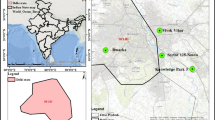Abstract
The measurement and monitoring of atmospheric pollutants is an important aspect of pollution studies. A novel method of assessment of the level of pollution in the atmosphere is conceived using point discharge and potential gradients. The present paper is an attempt to show that measurement of the point discharge current (PDC) and potential gradient (PG) can be used to provide information regarding the nature of charges and level of pollution in the atmosphere. The measurement of the PDC and PG in different localities is presented and discussed.
Similar content being viewed by others
References
Brasefield, C. J. (1959),Space Charge in Exhaust of Motor Vehicles, Science29,1610.
Chalmers, J. A.,Atmospheric Electricity, 2nd Edn. (Pergamon Press, London (1967).
Chree, C., andWatson, R. E. (1924),Atmospheric Pollution and Potential Gradients at Kew Observatory, Proc. R. Soc. Ser. A105, 311.
Israel, H. (1950),Zur Entwicklung der luftelektrischen Grundanschauungen Arch. Met, Wien A3, 1.
Kelvin, Lord (1860),Electricity, Atmospheric; Nichol's Cyclopaedia, 2nd ed. Papers onElectrostatics andMagnetism.
Manes, Alexander (1974),The Atmospheric-Electric Climate at the Greater Tel-Aviv Area (Israel) and its Correlation to the Particulate Air Pollution. Fifth International Conference on Atmospheric Electricity.
Mani, Anna, andHuddar, B. B. (1972),Studies of Surface Aerosols and their Effects on Atmospheric Electric Parameters, Pure appl. Geophys.100, 154.
Moore et al. (1962),Fair Weather Atmospheric Electric, P. G. and Space Charge over Central Illinois, Summer 1960, J. Geophys. Res.69 (3), 1061.
Muhleissen, R. (1953),Die luftelektrischen Elemente im Grossstadtbereich, Z. Geophys.29, 142.
Muhleissen, R.,Influence of Water on Atmospheric Electricity, Recent Advances in Atmospheric Electricity, (Pergamon Press, London (1958).
Mukerjee, S. M., andPillai, A. R. (1940),The Electrical Characterization of Days at Colaba (Bombay, India), During 1930–38, Terr. Magn. Atmos. Elect.45, 135.
Rao, A. M., andPatnaik, J. K. (1973),Influence of Pollution on Point Discharge Current, Curr. Sci.42, 14, 504.
Rao, A. M., andRamanadham, R. (1978),A Portable Instrument for the Measurement of Point Discharge Currents in the Atmosphere Using Junction FET's, Pure appl. Geophys.116 1114.
Rao.A. M., andRamanadham, R. (1979),Study of Transfer of Charge by Point Discharge in the Atmosphere, Pure appl. Geophys.117, 904.
Sapsford, M. B. (1937),Influence of Pollution on Potential Gradient at Apia, Terr. Magn. Atmos. Elect.42, 153.
Vonnegut, B. andMoore, C. B. (1961),Techniques for Introducing Low Density Space Charge into the Atmosphere, J. Geophys. Res.66 (3), 823.
Whipple, F. J. W. (1929),Potential Gradients and Atmospheric Pollution, the Influence of Summer Time, Q. Jl R. Met. Soc.55, 351.
Whitlock, W. S., andChalmers, J. A. (1956),Short Period Variations in the Atmospheric Electric Potential Gradients, Q. Jl R. Met. Soc.82, 325.
Author information
Authors and Affiliations
Rights and permissions
About this article
Cite this article
Rao, A.M., Nizamuddin, S. Atmospheric potential gradients and point discharge currents as a sensor of level of pollution. PAGEOPH 120, 108–116 (1982). https://doi.org/10.1007/BF00879430
Received:
Issue Date:
DOI: https://doi.org/10.1007/BF00879430




